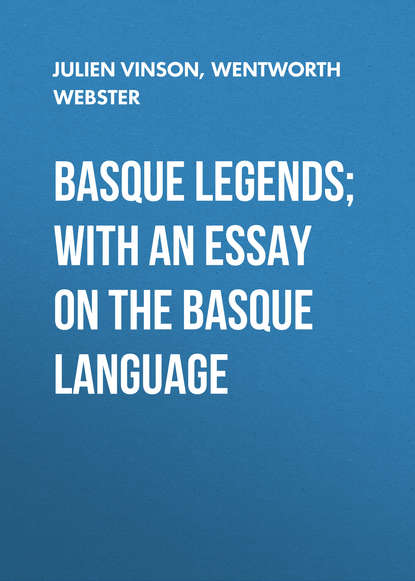По всем вопросам обращайтесь на: info@litportal.ru
(©) 2003-2024.
✖
Basque Legends; With an Essay on the Basque Language
Автор
Год написания книги
2018
Настройки чтения
Размер шрифта
Высота строк
Поля
117
Cf. below, p. 156.
118
The word “Ezkabi” is “the scab;” he either really had it, as in the next version, or was supposed to have it from keeping his head covered, as in this. In both cases the hair is most beautiful, precious, golden, and love-compelling.
119
Cf. with the whole of this tale, Campbell’s second tale, “The Battle of the Birds,” and the variations, especially the one of “Auburn Mary,” Vol. I. pp. 52–58.
120
Cf. Baring Gould’s chapter, “Swan-Maidens”—“Curious Myths of the Middle Ages,” p. 561, seq.
121
In the Gaelic the labours are more like those of Herakles—to clean out a byre, to shoot birds, and to rob a magpie’s nest. The Basque incidents seem to fit better into a climatological myth.
122
In “Old Deccan Days” (“Truth’s Triumph”) it is the hair and not the comb that does the wonders. In M. Cerquand’s “Récits” the comb is an attribute of the Basa-Andre.
123
In Campbell’s “Battle of the Birds” the hero always sleeps while the giant’s daughter does his task for him.
124
Here the narrator interposed, “You see it is just as it happens; the women are always the worst.” But in Campbell it is the giant himself who says, “My own daughter’s tricks are trying me.”
125
In Campbell the finger is lost in climbing the tree to get the magpie’s nest; but, as here, the bride is recognised by the loss of it.
126
In “Auburn Mary” the hero has to catch a young filly, “with an old, black, rusty bridle.”—Campbell, Vol. I., p. 55.
127
See below for a second marriage. In Campbell, p. 37, there is a double marriage.
128
In Campbell, p. 55, “Auburn Mary,” there is the same “talking spittle.”
129
Cf. “Truth’s Triumph,” in “Old Deccan Days;” and Campbell, pp. 33, 34; and supra, “Ezkabi-Fidel,” pp. 113, 114.
130
Campbell, pp. 34 and 56.
131
In Campbell, it is an old greyhound that kisses him, but with the same result, pp. 34 and 56.
132
In one of Campbell’s “Variations,” pp. 51, 52, the ending is something like this. In more than one, the hero marries another bride in his period of oblivion.
133
Cf. Campbell’s “The Chest,” Vol. II., p. 1. The tales seem almost identical.
134
The usual term for “the Pope;” the French, “Le Saint-Père.”
135
This is a curious testimony to an ancient practice. In the same way the Basques call “La Fête Dieu,” “Corpus Christi Day;” “Phestaberria,” “The New Feast,” though it was instituted in the thirteenth century.
136
This is a very old and wide-spread story. The Gaelic versions are given in Campbell, Vol. II., p. 239, seq. Cf. also Cox, “Aryan Mythology,” Vol. I., p. 111, seq.
137
In the Gaelic it is the bishop’s horse.
138
This is in the Norse and Teutonic versions.
139
This, again, is more like the Gaelic.
140
This name was written thus phonetically from the Basque, and it was not till I saw the Gaelic tale that it struck me that it is simply “Jean d’Ecosse”—“John of Scotland,” or “Scotch John.” In the analogous tale in Campbell, “The Barra Widow’s Son,” Vol. II., p. 111, we read—“It was Iain Albanach” (literally, Jean d’Ecosse) “the boy was called at first; he gave him the name of Iain Mac a Maighstir” (John, master’s son) “because he himself was master of the vessel.” This seems decisive that in some way the Basques have borrowed this tale from the Kelts since their occupation of the Hebrides. The Spanish versions, too, are termed “The Irish Princess” (Patrañas, p. 234).
141
See note on preceding page, and Campbell, Vol. II., p. 3.
Cf. below, p. 156.
118
The word “Ezkabi” is “the scab;” he either really had it, as in the next version, or was supposed to have it from keeping his head covered, as in this. In both cases the hair is most beautiful, precious, golden, and love-compelling.
119
Cf. with the whole of this tale, Campbell’s second tale, “The Battle of the Birds,” and the variations, especially the one of “Auburn Mary,” Vol. I. pp. 52–58.
120
Cf. Baring Gould’s chapter, “Swan-Maidens”—“Curious Myths of the Middle Ages,” p. 561, seq.
121
In the Gaelic the labours are more like those of Herakles—to clean out a byre, to shoot birds, and to rob a magpie’s nest. The Basque incidents seem to fit better into a climatological myth.
122
In “Old Deccan Days” (“Truth’s Triumph”) it is the hair and not the comb that does the wonders. In M. Cerquand’s “Récits” the comb is an attribute of the Basa-Andre.
123
In Campbell’s “Battle of the Birds” the hero always sleeps while the giant’s daughter does his task for him.
124
Here the narrator interposed, “You see it is just as it happens; the women are always the worst.” But in Campbell it is the giant himself who says, “My own daughter’s tricks are trying me.”
125
In Campbell the finger is lost in climbing the tree to get the magpie’s nest; but, as here, the bride is recognised by the loss of it.
126
In “Auburn Mary” the hero has to catch a young filly, “with an old, black, rusty bridle.”—Campbell, Vol. I., p. 55.
127
See below for a second marriage. In Campbell, p. 37, there is a double marriage.
128
In Campbell, p. 55, “Auburn Mary,” there is the same “talking spittle.”
129
Cf. “Truth’s Triumph,” in “Old Deccan Days;” and Campbell, pp. 33, 34; and supra, “Ezkabi-Fidel,” pp. 113, 114.
130
Campbell, pp. 34 and 56.
131
In Campbell, it is an old greyhound that kisses him, but with the same result, pp. 34 and 56.
132
In one of Campbell’s “Variations,” pp. 51, 52, the ending is something like this. In more than one, the hero marries another bride in his period of oblivion.
133
Cf. Campbell’s “The Chest,” Vol. II., p. 1. The tales seem almost identical.
134
The usual term for “the Pope;” the French, “Le Saint-Père.”
135
This is a curious testimony to an ancient practice. In the same way the Basques call “La Fête Dieu,” “Corpus Christi Day;” “Phestaberria,” “The New Feast,” though it was instituted in the thirteenth century.
136
This is a very old and wide-spread story. The Gaelic versions are given in Campbell, Vol. II., p. 239, seq. Cf. also Cox, “Aryan Mythology,” Vol. I., p. 111, seq.
137
In the Gaelic it is the bishop’s horse.
138
This is in the Norse and Teutonic versions.
139
This, again, is more like the Gaelic.
140
This name was written thus phonetically from the Basque, and it was not till I saw the Gaelic tale that it struck me that it is simply “Jean d’Ecosse”—“John of Scotland,” or “Scotch John.” In the analogous tale in Campbell, “The Barra Widow’s Son,” Vol. II., p. 111, we read—“It was Iain Albanach” (literally, Jean d’Ecosse) “the boy was called at first; he gave him the name of Iain Mac a Maighstir” (John, master’s son) “because he himself was master of the vessel.” This seems decisive that in some way the Basques have borrowed this tale from the Kelts since their occupation of the Hebrides. The Spanish versions, too, are termed “The Irish Princess” (Patrañas, p. 234).
141
See note on preceding page, and Campbell, Vol. II., p. 3.
Другие электронные книги автора Wentworth Webster
Spain




 0
0






